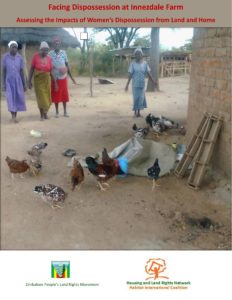Assessing the Impacts of Women’s Dispossession from Land and Home

This document is a glimpse of what is at stake for many Zimbabweans post-land reform with a view to the consequences of insecure tenure and ambiguous land titles in a policy vacuum. It constitutes a baseline survey as an example of what is entailed in counting the costs of post-resettlement displacements and tenure insecurity in Zimbabwe’s land reform program.
This report, as part of Housing and Land Rights Network (HLRN) project Assessing Impacts of Women’s Dispossession from Land and Home, is the result of a field research on farm displacements implemented by the Zimbabwe People’s Land Right Movement and HLRN. It presents the findings of a field survey that seeks to quantify the potential losses, costs and damage to women-headed families in cases of forced evictions, as has been the case for some families in the Sokis resettlement community at Innezdale Farm – one of the 5-acre A1 models that were re-allocated to farmers under the Fast Track Land Reform Program (FTLRP) – in Mhondoro Ngezi, Kadoma District, Zimbabwe. These pending forced evictions, due to dispute tenure by competing beneficiaries of the FLRTP in the absence of a national land policy, have a direct bearing on productivity and violate these families’ human rights related to habitat, including their human rights to adequate housing, land, water, livelihood with the continuous improvement of living conditions and meaningful participation. These human rights are guaranteed under the International Covenant on Economic, Social and Cultural Rights (Article 11), which Zimbabwe ratified on 13 August 1991.
 Read the report: Facing dispossession at Innezdale Farm_Zimbabwe
Read the report: Facing dispossession at Innezdale Farm_Zimbabwe
The findings and recommendations of this report will be useful as input into the land-policy consultations and formulation currently underway (June 2021) and a contribution to the indispensable quantification of losses, costs and damage due to gross violations of human rights, including the forced evictions in Zimbabwe’s land reform settlement areas. These research findings will also ground recommendations to be mainstreamed in the country’s National Development Strategy 1 (NDS1), in pursuit of the 2030 Agenda of Sustainable Development Goals (SDGs) and the National Voluntary Review toward meeting their respective targets and indicators.
HLRN and ZPLRM embarked on an in-depth case study on the effectes of dispossession, including all-important quantification of losses in such incidents as forced evictions.
The study selected for its representativity, relevance to policy and potential for remedy focused on the Sokis community who are beneficiaries of the FTLRP at Innezdale Farm, localted about 200 km southwest of Harare, the capital of Zimbabwe. In particular, it looks into the values at stake of the A1 resettlement community of 222 families on the 1,110-hectare Innezdale farm. These families occupied this farm in 2000 during the FTLRP, and are living under threat of forced evictions as their tenures is disputed. Already in March 2018, about 50 of these families had their propiety and houses destroyed as a consequence.
The ZPLRM, with the help of partners and friends, managed to obtain a High Court order stopping the further evictions, granting the community temporary relief as the tenure security issue is yet to be resolved. This is the plight of hundreds, if not thousands of resettlement communities accross the country who are the beneficiaries of the land reform programme, with its complex tenure security system.
The primary focus was on female-headed households (single, widowed, divorced, females child-headed). A total of 57 families participated in the in-depth study, while 11 families expressed reservations about participating in the survey, mostly due to fear of being victimised by political, local and national authorities.

Read the report: Facing dispossession at Innezdale Farm_Zimbabwe